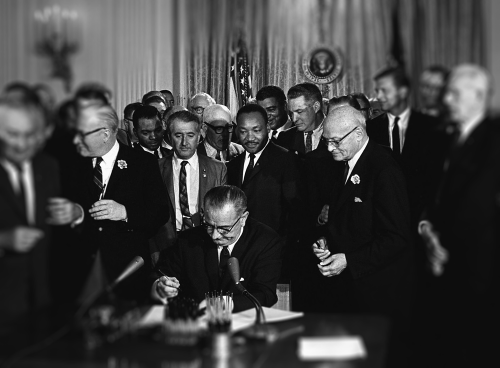Civil Rights Act of 1964
 |
|
President Lyndon Johnson signs the Civil Rights Act
as Dr. Martin Luther King looks on, July 2, 1964.
Photo: C. Stoughton, White House Press Office.
|
Overview
Title I: Bars unequal application of voter registration requirements.
Title II: Outlaws discrimination in hotels, motels, restaurants, theaters, and all other public accommodations engaged in interstate commerce.
Title III: Prohibits state and municipal governments from denying access to public facilities.
Title IV: Encourages the desegregation of public schools and authorized the U.S. Attorney General to file suits to enforce the act.
Title V: Expands the Civil Rights Commission established by the earlier Civil Rights Act of 1957 with additional powers, rules and procedures.
Title VI: Prevents discrimination by government agencies that receive federal funds.
Title VII: Prohibits employment discrimination on the basis of race, color, religion, sex or national origin. (The Equal Employment Opportunity title has been widened to prohibit pregnancy, age, and disability discrimination.)
Title VIII: Requires compilation of voter-registration and voting data in geographic areas specified by the Commission on Civil Rights.
Title IX: Makes it easier to obtain fair hearing by moving civil rights cases from state courts to federal court.
Title X: Establishes the Community Relations Service, and office in the U.S. Department of Justice tasked with assisting in the resolution of discrimination claims.
Title XI: Gives a defendant accused of certain categories of criminal contempt in a matter arising under title II, III, IV, V, VI, or VII of the Act the right to a jury trial.